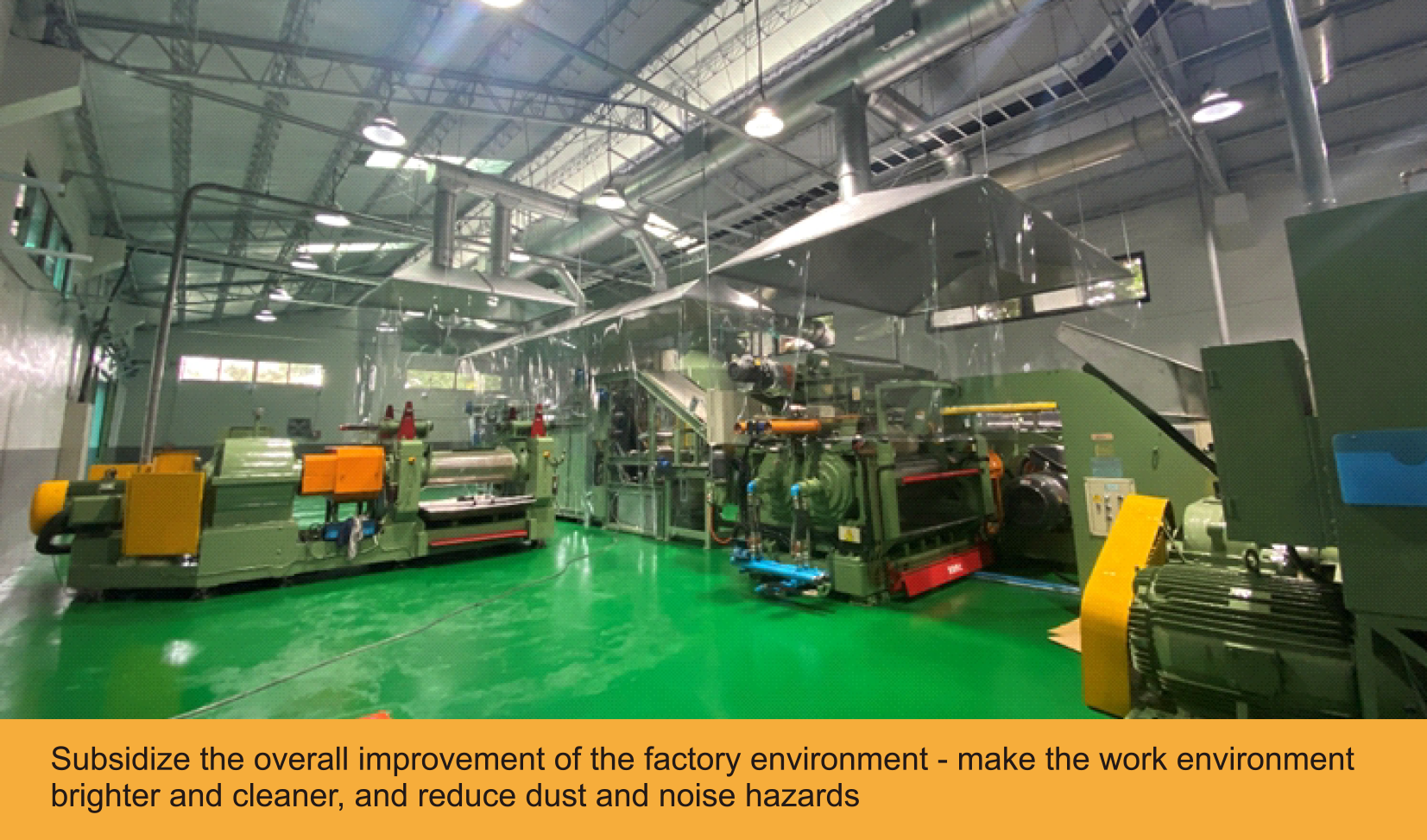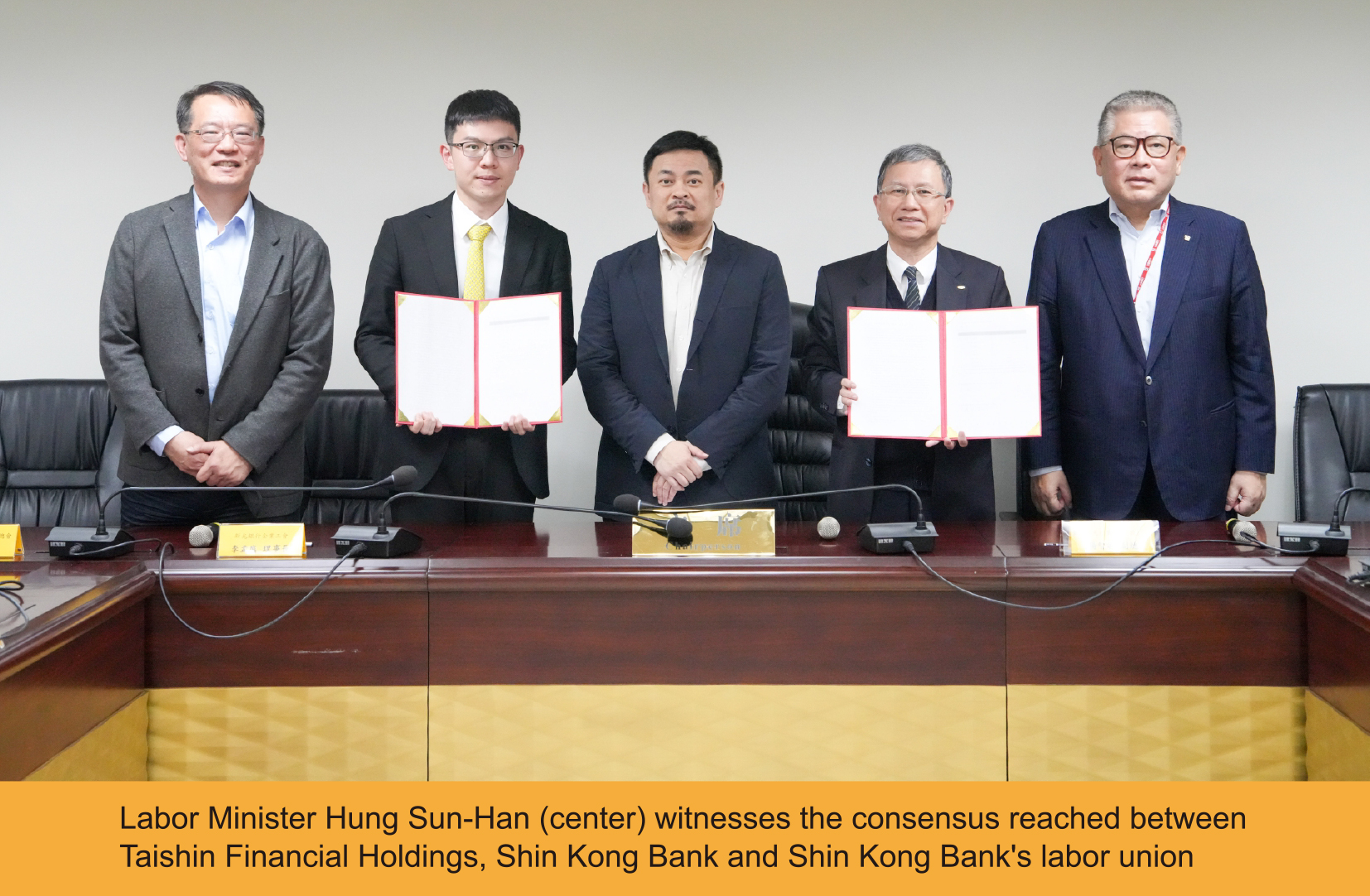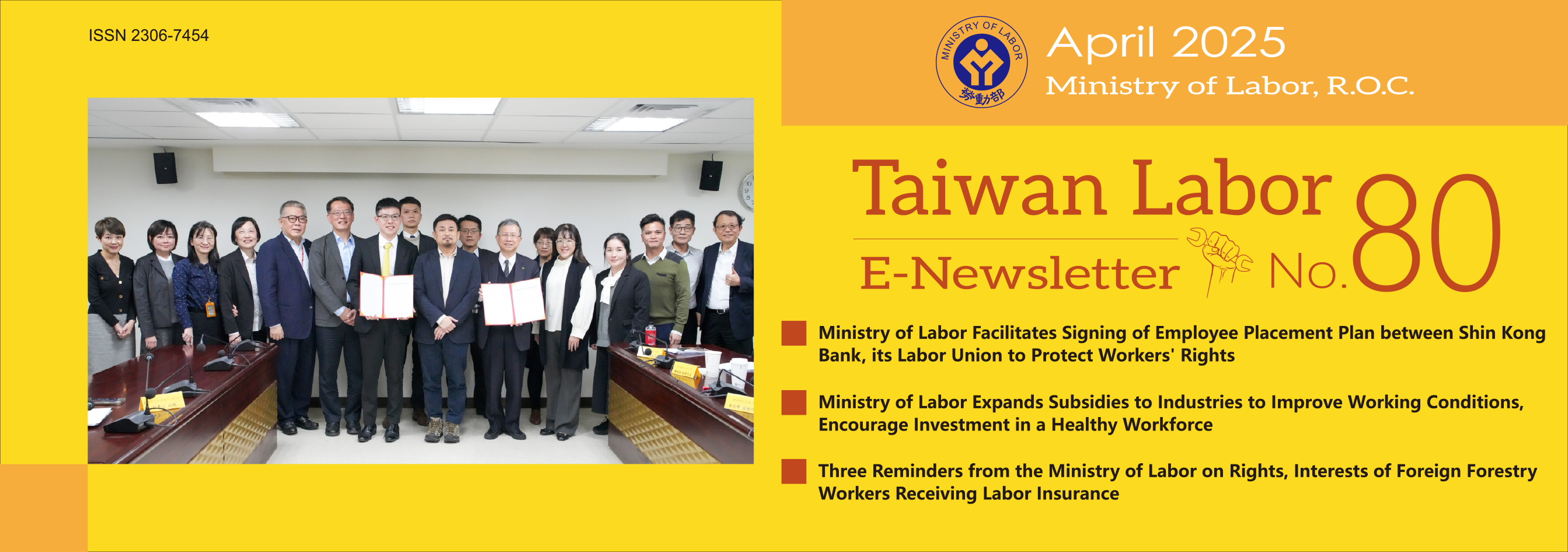NO.80
- Last updated:2025-04-29
- Clicks on the following title, but browses this article fast
- Policies & Regulations Ministry of Labor Expands Subsidies to Industries to Improve Working Conditions, Encourage Investment in a Healthy Workforce What Happens if Foreign Caregivers Become Seriously Ill? Government to Provide Employers with Assistance! Three Reminders from the Ministry of Labor on Rights, Interests of Foreign Forestry Workers Receiving Labor Insurance
- News Outlook Ministry of Labor Facilitates Signing of Employee Placement Plan between Shin Kong Bank, its Labor Union to Protect Workers' Rights Bureau of Labor Insurance Covers the Fees of Health Examination for Prevention of Occupational Disease Overview of Employment Management, Workplace Equality in 2024
Ministry of Labor Expands Subsidies to Industries to Improve Working Conditions, Encourage Investment in a Healthy Workforce

To assist 3K traditional industries, that is industries with working conditions that are dirty, dangerous and strenuous, in improving their work environment and enhancing the health of their workforce, the Ministry of Labor (MOL) established a "Subsidy Program for Improving Safety and Health in Work Environments in Specific Processing Industries." This year, the eligibility of the subsidy will be extended to companies with less than 299 workers, making more companies willing to invest in health and safety. In addition, since crystalline free silica is classified as a Group 1 carcinogen by the International Agency for Research on Cancer (IARC), and long-term occupational exposure may lead to diseases such as pulmonary fibrosis and cancer, the subsidy amount given to this kind of businesses has been increased to NT$3.5 million this year to safeguard workers' health. The MOL aims to encourage enterprises to proactively improve engineering control equipment and their work environment. In addition, for the first time, the MOL signed Memorandums of Understanding (MOUs) with industry associations last year, for which the associations are positioned as collaborative platforms. Member companies proactively participated in workplace improvement meetings, promotional activities, and the development of technical documents. As a result, the subsidy amount for associations was increased to NT$500,000 to encourage them to proactively improve occupational health and safety standards within their respective industries.
Since 2014, this program has managed to subsidize enterprises in casting, surface treatment, dyeing and finishing, rubber, and plastic products-related industries. Over the past 10 years, a total of 912 companies have been visited and counseled, while 349 companies have been subsidized, with the amount of subsidies reaching nearly NT$356 million. This program has resulted in a total of NT$3.35 billion in investments made by companies to improve their operations. Last year, all participating associations established occupational health and safety promotion groups, organized 7 events such as exchange and observation meetings, and jointly developed 17 technical documents with member factories. The documents are published on websites of the associations, or magazines for reference by the industries to improve occupational health and safety standards.
The MOL indicated that the subsidy program has been expanded to cover all traditional industries with specific processes. Enterprises are encouraged to make full use of the program to enhance engineering control efficiency and improve the overall factory environment. They are encouraged to break the long-standing stereotype of traditional factories as environments that are damp, dimly lit, hot, stuffy, noisy, dusty, and filled with chemical odors. The improvement will thereby attract and retain talent, enhancing worker health and safety, and promoting sustainable development for businesses. For related information, please visit the "Information on Guidance for Specific Processing Industries" (URL: https://3kto3c.osha.gov.tw/).
Keywords: Improve Work Environments in Specific Processing Industries, Work with Industry Associations to Promote Occupational Health and Safety, Enhance the Health and Safety of the Workforce
What Happens if Foreign Caregivers Become Seriously Ill? Government to Provide Employers with Assistance!

What happens when a foreign care worker suffers serious injury or becomes very ill? On March 10, 2025, the Ministry of Labor (MOL) officially launched "Integrated Services for Live-in Foreign Care Workers Suffering Serious Injury or Illness." This service provides support mechanisms for employers when the foreign worker they hire is unable to continue working and providing care due to serious injury or illness, alleviating the burden on employers while ensuring foreign workers receive appropriate care.
As of the end of January 2025, 197,742 foreign care workers were legally employed in Taiwan. However, when a live-in foreign care worker suffers from a serious injury or illness, the employer faces the challenge of caring for the care worker and having no one to look after the original care recipient. As a result, the MOL established an integrated service for live-in foreign care workers suffering serious injuries and illnesses. As soon as the employer reports the matter to a local government foreign workers consultation service center or the 1955 workers' counseling and complaints hotline, the local government activates the single-window integrated service model. Thereafter, personnel are dispatched to learn about the foreign care worker's physical and mental condition and the employer's home care needs, followed by the provision of appropriate referrals, consultations, and assistance.
In addition, the local government also coordinates with the representative office of the care worker's home country in Taiwan in an effort to contact his or her family. It also provides support services based on the needs of the foreign care worker, including placement services and medical assistance. At the same time, the employer receives all necessary support, including assistance in applying for "Expanded Respite Services for Families That Employ Live-in Foreign Care Workers", or "Short-term Alternative Care Services for Families That Employ Live-in Foreign Care Workers." The toll-free 1955 Hotline proactively follows up on the status of employers and foreign care workers within one month of receiving a report, to ensure both parties have received proper assistance.
The MOL indicates that the implementation of the integrated service for live-in foreign care workers suffering from serious injuries or illnesses provides employers with comprehensive assistance while ensuring the foreign care workers receive health, work and life related help. This ensures harmonious relations between workers and employers and benefits both parties. If you would like to learn more about the mechanisms, call the toll-free 1955 Hotline.
Keywords: Foreign Workers Who Fall Ill, Foreign Workers with a Serious Injury or Illness, Integrated Services for Serious Injuries and Illnesses
Three Reminders from the Ministry of Labor on Rights, Interests of Foreign Forestry Workers Receiving Labor Insurance

The Labor Insurance assigns employers the responsibility and obligation to enroll their workers in the insurance program. Employers engaging in forestry work who hire foreign workers must, in accordance with regulations, register as an insured unit with the Bureau of Labor Insurance (BLI) and enroll their foreign workers in the labor insurance program. The Ministry of Labor (MOL) offers three major reminders:
I. According to the Labor Insurance Act, forest farms, non-profit organizations, and cooperative enterprises that employ five workers or more (including both domestic and foreign employees) are required to enroll their workers in labor insurance as mandatory insured units. For those employing four or fewer workers, employers may opt to enroll them in labor insurance. In addition, regardless of the number of employees, labor occupational accident insurance must be provided for employees in accordance with the Labor Occupational Accident Insurance and Protection Act.
II. The MOL has indicated that in response to practical needs, natural persons who are forest farm employers can use the "Recognition of Forestry Employer Eligibility for Hiring of Foreign Workers" issued by the Ministry of Agriculture (MOA) as the relevant certification document when they apply to the BLI to establish an insured unit, and enroll their foreign workers in labor insurance and labor occupational accident insurance.
III. The MOL reminds that, to address seasonal labor shortages, the MOA has established an outreach agricultural labor service model for employers hiring foreign workers. Under this model, outreach agricultural employers, who are farmers' associations (as non-profit organizations) or agricultural, forestry, fishery, and animal husbandry cooperatives hiring and assigning foreign workers to perform physical labor directly at the contracted work sites, are also required to have their foreign workers participate in labor insurance and labor occupational accident insurance in accordance with regulations. If there are any further questions regarding participation in the insurance, please contact the BLI (tel: 02-2396-1266).
Keywords: Labor Insurance, Forestry Work, Foreign Workers
Ministry of Labor Facilitates Signing of Employee Placement Plan between Shin Kong Bank, its Labor Union to Protect Workers' Rights

To facilitate a consensus between Taishin Financial Holding, Shin Kong Bank, and the Shin Kong Bank labor union on the employee placement plan and to safeguard the rights of employees affected by the merger, the Ministry of Labor (MOL) convened another tripartite meeting in the afternoon of February 25, 2025. Han Shih-Hsien, General Secretary of the Taiwan Federation of Financial Unions, also attended to provide support. The discussion was intensive on key unresolved issues. Nevertheless, all three parties demonstrated utmost goodwill, and after five hours of negotiations, a consensus was successfully reached. Labor Minister Hung Sun-Han was also present to witness the signing of the employee placement plan by the labor-management negotiation representatives. He held the results of the cooperation and negotiation between the labor and management in high regard.
The MOL has always attached great importance to labor-management negotiations and employee rights protection in the mergers and acquisitions of financial institutions. It has long cooperated with the Financial Supervisory Commission (FSC) to require financial institutions to properly negotiate employee placement plans with unions during mergers, protecting the rights of employees after the merger. The MOL also assists labor and management in reaching a consensus through fair and equal negotiations in various ways. Minister Hung, apart from witnessing the signing of the agreement that day, expressed gratitude for the efforts made by labor, management, and the union in negotiating and communicating based on a shared commitment to providing the best care for employees. He also expressed hope that, following the merger of Taishin Bank and Shin Kong Bank, employees retained would be able to continue working with peace of mind. Furthermore, he mentioned how a good communication and interaction model should be established with the labor union to jointly create a brighter future for Taishin Bank.
Last but not least, the MOL also called on financial institutions to follow the practice of negotiating with labor unions on employee placement when planning for mergers in the future. The MOL will also work with the FSC to assist in jointly protecting workers' rights by facilitating labor-management cooperation.
Keywords: Financial Institution Mergers and Acquisitions, Employee Placement Plan, Negotiation
Bureau of Labor Insurance Covers the Fees of Health Examination for Prevention of Occupational Disease

To prevent the occurrence of occupational diseases for workers in high-risk occupations and settings and to protect the health of insured persons, workers in environments with exposure to 32 hazardous operations (e.g., high temperature, noise, dust) or those with prior exposure to 16 types of hazardous operations (e.g., ionizing radiation, nickel, formaldehyde) and who have participated consecutively in the labor insurance program for one year or more may apply to the Bureau of Labor Insurance (BLI) for an annual Health Examination to Prevent Occupational Disease and Follow-up Health Examination, with the BLI covering the fees of such examination.
The BLI sends annual reminders to insured units. Workers who meet the criteria to apply for the Health Examination to Prevent Occupational Disease must do so through such units. If an examination reveals abnormal results, the BLI will proactively notify the worker to seek follow-up care at an occupational medicine clinic. Workers diagnosed with an occupational disease are eligible to apply for relevant occupational accident insurance benefits.
Additionally, for workers who have engaged in the above 16 types of hazardous operations, after changing jobs, leaving their jobs, or withdrawing from insurance, they can also apply to the BLI for a Follow-Up Health Examination for Prevention of Occupational Disease. Workers who, following an abnormal examination result, are diagnosed with an occupational disease by an occupational medicine specialist during the insured period, are eligible for the aforementioned occupational accident insurance benefits. If a worker, after his/her separation from work or withdrawal from the insurance, is diagnosed with an occupational disease by an occupational medicine specialist at a dedicated medical institution approved by the Ministry of Labor, he/she may apply for the relevant allowance or subsidies against such occupational disease if it is caused by the performance of duties during the insured period.
To obtain the information about the Health Examination to Prevent Occupational Disease and Follow-up Health Examination, occupational accident insurance benefits, and the allowances/subsidies against occupational diseases diagnosed after withdrawal from the insurance, please visit the Business Topic section of the BLI's global website: "Labor Occupational Accident Insurance - Health Examination to Prevent Occupational Disease and Follow-up Health Examination and Insurance Benefits" (https://www.bli.gov.tw/en/0016007.html).
Keywords: Health Examination to Prevent Occupational Disease, Follow-up Health Examination to Prevent Occupational Disease, Hazardous Operations
Overview of Employment Management, Workplace Equality in 2024

To learn about the implementation of the Gender Equality in Employment Act and the actual status of equal employment in the workplace, the Ministry of Labor (MOL) conducted an employment management/workplace employment equality overview survey from August to September 2024, with "industry establishments" and "employees" as the survey subjects respectively. Among which, 3,114 valid samples were collected from industry establishments and 6,901 from employees (4,801 from women and 2,100 from men). The statistical results of the survey are summarized as follows:
I. Sexual harassment prevention
i. Industry establishments with more than 30 employees which have formulated "procedures for sexual harassment prevention measures, reporting, and punishment" account for 89%.
ii. Female and male employees who indicate that they have not experienced sexual harassment in the workplace in the past year account for 96% and 99% respectively. The most common form of sexual harassment experienced by female employees is non-physical contact (including verbal harassment, voyeurism, voyeuristic recording, stalking, messaging, indecent exposure), accounting for 1.9%, followed by gender-based discriminatory remarks and behavior at 0.8%.
II. Measures to promote work equality
i. The highest granting rate for maternity-related leave types by industry establishments is for "maternity leave" at 95.1%, followed by "prenatal rest leave" and "miscarriage leave" at 92.9% and 92.7%, respectively. The granting rates for "paternity check-up and paternity leave," "menstrual leave," and "pregnancy checkup leave" amount to 89.8%, 87.7%, and 86%, respectively.
ii. Industry establishments with more than 100 employees which have set up "childcare service entities," or provided "childcare facilities" account for 78%; those which have established "breastfeeding rooms" account for 84%.
III. Employment discrimination
i. The highest proportion of industry establishments that take gender into consideration for various operations is in "work allocation" at 15.8%, followed by "salary and wages standards" at 4.1%, and "unpaid parental leave for raising children" at 3.5%. In terms of considerations for transgender and sexual orientation, "work allocation" also ranks highest at 6.5%.
ii. In the past year, the highest reported rate of gender-based unequal treatment encountered by female employees is related to "salary adjustment" at 2.8%, and "work allocation" for male employees at 1.9%.
iii. In the past year, the most common reason for workplace discrimination other than gender for both sexes is "age," affecting 3.6% of women and 4.5% of men.
Keywords: Gender Equality in Employment Act, Workplace Sexual Harassment Prevention, Employment Discrimination
- Source:Department of General Planning
- Publication Date:2025-04-30
- Count Views:
File
- Taiwan Labor E-Newsletter No80 pdf

